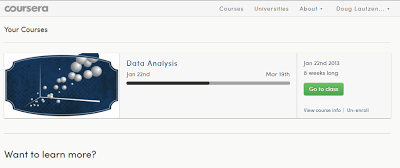I am now in the homestretch of a Coursera MOOC that lasts eight weeks.
I am now in the homestretch of a Coursera MOOC that lasts eight weeks. At the five-week milestone of a Data Analysis course using the R statistical programming language, I have survived four weekly quizzes and the first written assignment. See my original posting for the back story.
Seriously, I almost didn’t take the very first quiz. It was that intimidating. But after passing three of them, I started to feel pretty good. Perhaps I was even ready for a sexy Data Scientist swagger.
But then a major setback shook my confidence: I saw the Data Analysis written assignment. You had to download data, sift through it for associations, generate graphs, and write a paper. I fumbled with the data analysis for quite a while. I considered admitting defeat and just watching the lectures in the future. Mark it as an “audit” instead of a graded certificate.
I went to bed on Friday night thinking, “This is crazy! I don’t have the time for this stuff. This course isn’t that important.”
Luckily for my scholastic endeavors, by 6:30am the next morning my attitude had improved and I knocked out the assignment within four hours. What had stopped me the previous night was dirty data. The bums had made the data bad so that your first step needed to be to convert formats and clean things up. In the morning, I had the presence of mind to look through the course discussion forums and read the comments of other disgruntled students who had already commented on the dirty-data-trick. You see, in real life, you have to deal with dirty data. The teacher was making a point in the assignment.
Whoever thinks an online college course is easier than a “real” class sitting in a classroom is very mistaken. This is serious stuff.
One major issue with the assignment was timing. The teacher assigned it during Week 3, but I wouldn’t understand how to do it until after Week 4’s lectures and quiz. I finished the assignment before I knew what I was doing.
Because there are thousands of students, the teacher cannot grade the assignments. Instead, he needs the students to grade each other according to a standard Yes/No rubric where each evaluation question is worth zero to five points. Each student has to evaluate the work of four peers or receive a 20% deduction in their assignment grade.
After I submitted my assignment and started on the peer reviews, I immediately got that “oh crap” feeling. Looking at the work of others, I started to gain a better insight into what the teacher might have wanted. Compared to theirs, my data analysis seemed pretty simple. At the time, I didn’t understand how to use R to program a linear model with confounding, interacting variables. Confound it!
Oh well, my data analysis report was formatted nicely and the R graphs looked pretty; I can only hope my peer graders will be gracious and overlook my simple statistics. To get the positive karma flowing, I gave all of my peers perfect scores.
